In recent years, Sino-European bilateral trade has achieved rapid development, and China has become the EU's largest source of imports and the second largest destination of exports. Frequent trade exchanges have led to a sharp increase in the logistics demand of China-Europe commodity trade, which has also brought new challenges to China's product export operation model. The China-Europe Express has opened up a railway channel between China and Europe, which has greatly improved the slow and unstable problem of traditional European shipping.
This progress has opened up a new prelude for China's railways to enter the world's rail freight industry. In just a few years, the "Belt and Road" strategy has continuously stimulated the trade needs between China and the countries along the "Belt and Road". The number and radiation of China-Europe trains The scope is constantly improving. However, no matter in terms of operation organization, operation mode or coordination mechanism, the existing direct transportation mode of China-Europe Express Express has many problems, such as the low normalization rate of the line, the duplication of routes, the high return rate of empty containers, and the competition of supply from different cities, etc. , Has affected the balanced development of China-Europe Express.
Therefore, to improve the shortcomings of the point-to-point direct transportation mode of the China-Europe Express, it is necessary to follow my country's economic layout, port distribution and the construction of international corridors, use several cities as hubs, innovate China-Europe transportation methods, and construct the hub and spokes of the China-Europe Express. International logistics and transportation network, all parts of the country carry out "shared trains, combined transportation". After full load, it passes through the border land port nodes and European hub cities, and finally reaches the European destination cities, realizing "group assembly, scattered transfers", and reduce Operating costs, avoid waste of transportation capacity, and ensure the normal operation of high-frequency trains.


 English
English Spanish
Spanish Arabic
Arabic